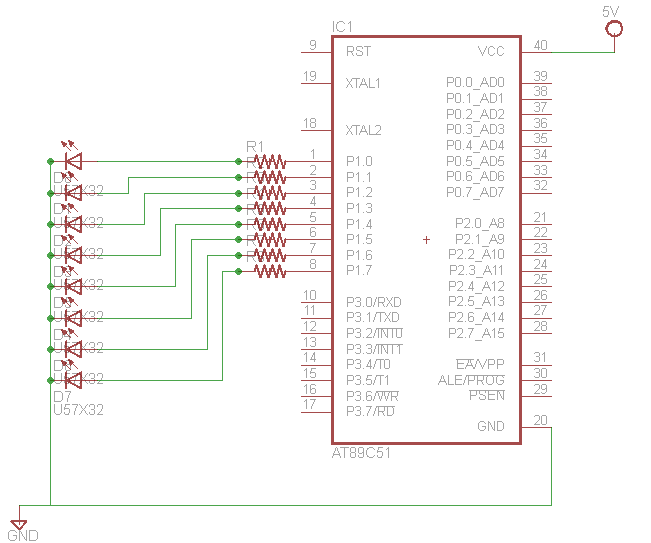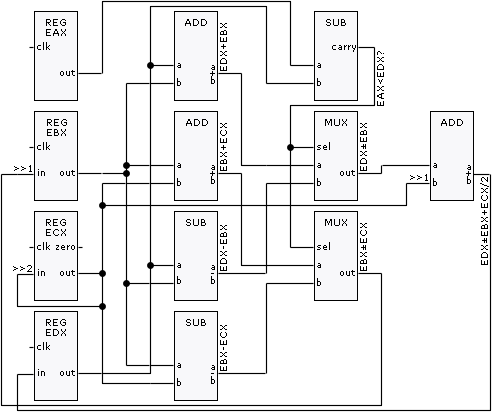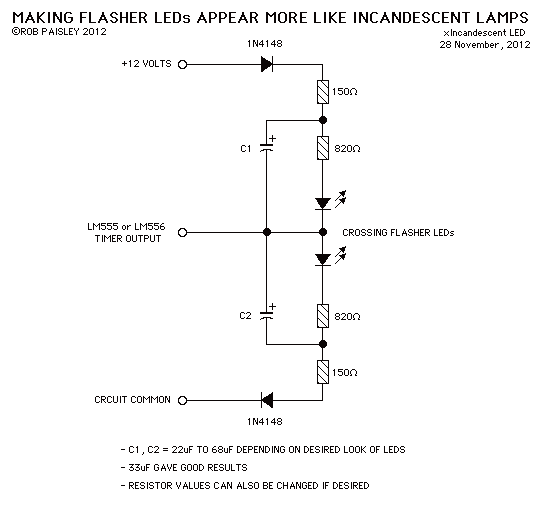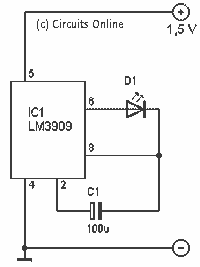
A Mixed-Signal LED Clock
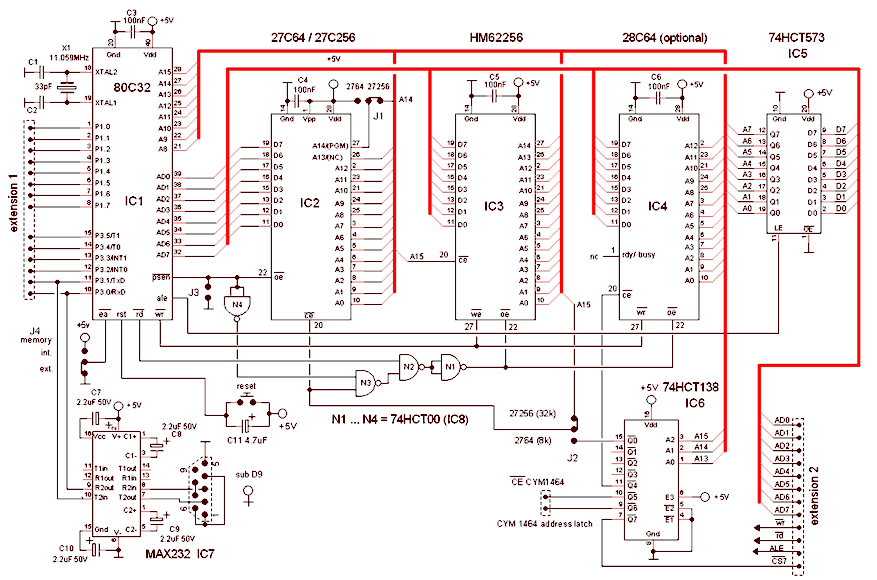
The term "mixed-signal" typically refers to circuits and integrated circuits (ICs) that process both analog and digital signals. In this context, the designation "A mixed-signal LED clock" may be somewhat misleading, as this is a fully digital clock. However, the readout is analog, and the term "mixed-signal" was chosen for naming purposes. In the mid-1980s, involvement with the Eindhoven Computer Association (ECA), a microcomputer club in Eindhoven, provided access to surplus electronic components, including LEDs in various shapes and colors. This inspired the design of a clock featuring an analog display. Although the creator typically prefers using prefabricated breadboard cards for circuits, the circular design of the LED clock necessitated the etching of a printed circuit board (PCB), completed in the summer of 1987. After initial assembly, the project was set aside but was later revived as the first PIC processor project. The clock's circuit is straightforward, featuring a mechanical bell that strikes the hours, adding a homely touch to the device. The second, minute, and hour LEDs are arranged in a time-multiplexed matrix configuration, with the anodes connected to rows and cathodes to columns. The hour hand consists of five series-connected LEDs, requiring a minimum supply voltage of 12V. Discrete transistor drivers are employed for both anodes and cathodes, with 330-ohm resistors controlling LED current and brightness. The specific resistor values may require experimental adjustment based on supply voltage and LED color. The circuit utilizes a PIC16F84 processor, which is now outdated, but a pin-compatible PIC16F628 can be used with minor software modifications. Due to limited I/O capabilities of the PIC16F84, an 8-bit latch (74HC563) is employed to expand output options, while a HEF4028 1-of-8 decoder manages the anode row switching.
The mixed-signal LED clock integrates both analog and digital functionalities, offering a unique approach to timekeeping. The design features an innovative combination of mechanical and electronic elements, allowing for a visually appealing and functional timepiece. The mechanical bell not only serves as an auditory indicator of the hour but also enhances the overall aesthetic of the clock, providing a nostalgic touch reminiscent of traditional clocks.
The matrix configuration of the LEDs allows for efficient multiplexing, where only one row of anodes is activated at any given time. This minimizes power consumption while maximizing the visual impact of the display. The choice of using discrete transistors for driving the LEDs ensures reliable operation and allows for easy adjustments to brightness through resistor selection. The use of a 12V supply voltage is particularly advantageous, as it enables the use of standard LED configurations while ensuring sufficient brightness for visibility.
The choice of the PIC16F84 microcontroller, despite its obsolescence, demonstrates a practical approach to utilizing available resources. The transition to the more modern PIC16F628 is straightforward, requiring minimal changes to the existing software, thus ensuring continued relevance of the design. The integration of the 74HC563 latch facilitates expanded output capabilities, allowing for more complex driving of the LED matrix without overwhelming the limited I/O of the microcontroller.
Overall, the mixed-signal LED clock presents a compelling example of how traditional clock design can be enhanced with modern electronic components, resulting in a unique and functional device that bridges the gap between analog and digital technologies.The term "mixed-signal" is usually reserved for circuits and ICs that process both analog and digital signals. In that sense the title "A mixed-signal LED clock" is perhaps misleading since this is a digital clock from beginning to end.
However, the readout is analog and since the beast had to be given a name, I a called it my "mixed-signal" clock . Somewhere in the middle of the eighties, when I was studying, I joined the ECA: the Eindhoven Computer Association, a microcomputer club in Eindhoven. Although I am not a member anymore, they still exist and have now been active for more than 25 years [1].
Being situated in Eindhoven, the club obviously had close links with Philips, and regularly obtained surplus supplies of components of various kinds. I remember that these components could be bought for fl 0. 10 (10 guider cents) a piece on every Tuesday evening. At one time they had a batch of LEDs in various shapes and colors. In those days a LED was not quite the common component it is today. The availability of these LEDs in these beautiful colors and nice shapes suggested the idea for a clock with an analog clock face.
Normally, I never bother about making a printed circuit board for my circuits. I prefer working on these cheap prefabricated pertinax breadboard cards. However, for the circular face of my LED clock I had no other alternative than to etch a PCB (Fig. 1). I made it in the summer of 1987, and after I had placed the LEDs and finished the wiring, I put it into a drawer. There it was forgotten due to more pressing projects (girls and examinations). Two years ago I found it again and decided to finish the clock. It actually became my first PIC processor project. The circuit of the clock contains no real surprises. A (literally) striking feature about this clock is that it has a real mechanical bell which strikes the hours.
It gives the clock quite an homely appearance, and it has became a much valued member of our household. As mentioned, the circuit of the "Mixed-Signal" clock is rather straight forward. Since the second, minute and hour LEDs could be time multiplexed, the LEDs are connected in a matrix (Fig.
2). The anodes of the LEDs are connected to the rows, the cathodes to the columns. For the hours hand, five LEDs connected in series have been used. This additionally sets the supply voltage to a minimum of 12V. Both for the anodes as well as for the cathodes, drivers with discrete transistors have been used. The two resistors of 330 ohm in the anode drivers set the current through the LEDs and hence their brightness. The left 330 ohm resistor (connected to rows A. E) sets the current through the seconds and minutes LEDs while the right LED (connected to row F) sets the current through the hours LEDs.
You will have to determine the proper value of these resistors experimentally. The value of 330 ohm is just a starting value and depends on the exact supply voltage, and the color of the LEDs used. Especially the resistor for the hours LEDs will be much smaller, typically something in the range of tens of ohms.
The 16F84 processor used here is a little bit out dated and no longer in production. I used it because of the simple fact that I had it lying around. The more modern 16F628 is pin compatible and will perform equally well. The 16F628 controller requires some minor software modifications. The source and hex files for both the 16F84 and the 16F628 have been included in the download section at the bottom of this page. The 16F84 has too few I/Os to address all the anode and cathode drivers directly (Fig. 3). A 74HC563 8 bits latch was used to extend the number of outputs by another 8 bits at the expense of a latch enable signal taken from port A.
The eight outputs from the latch, together with the lowest 4 bits of port B from the PIC drive address the cathode drivers. Since only one of the anode rows is switched on at any given moment, a HEF4028 1-o 🔗 External reference
The mixed-signal LED clock integrates both analog and digital functionalities, offering a unique approach to timekeeping. The design features an innovative combination of mechanical and electronic elements, allowing for a visually appealing and functional timepiece. The mechanical bell not only serves as an auditory indicator of the hour but also enhances the overall aesthetic of the clock, providing a nostalgic touch reminiscent of traditional clocks.
The matrix configuration of the LEDs allows for efficient multiplexing, where only one row of anodes is activated at any given time. This minimizes power consumption while maximizing the visual impact of the display. The choice of using discrete transistors for driving the LEDs ensures reliable operation and allows for easy adjustments to brightness through resistor selection. The use of a 12V supply voltage is particularly advantageous, as it enables the use of standard LED configurations while ensuring sufficient brightness for visibility.
The choice of the PIC16F84 microcontroller, despite its obsolescence, demonstrates a practical approach to utilizing available resources. The transition to the more modern PIC16F628 is straightforward, requiring minimal changes to the existing software, thus ensuring continued relevance of the design. The integration of the 74HC563 latch facilitates expanded output capabilities, allowing for more complex driving of the LED matrix without overwhelming the limited I/O of the microcontroller.
Overall, the mixed-signal LED clock presents a compelling example of how traditional clock design can be enhanced with modern electronic components, resulting in a unique and functional device that bridges the gap between analog and digital technologies.The term "mixed-signal" is usually reserved for circuits and ICs that process both analog and digital signals. In that sense the title "A mixed-signal LED clock" is perhaps misleading since this is a digital clock from beginning to end.
However, the readout is analog and since the beast had to be given a name, I a called it my "mixed-signal" clock . Somewhere in the middle of the eighties, when I was studying, I joined the ECA: the Eindhoven Computer Association, a microcomputer club in Eindhoven. Although I am not a member anymore, they still exist and have now been active for more than 25 years [1].
Being situated in Eindhoven, the club obviously had close links with Philips, and regularly obtained surplus supplies of components of various kinds. I remember that these components could be bought for fl 0. 10 (10 guider cents) a piece on every Tuesday evening. At one time they had a batch of LEDs in various shapes and colors. In those days a LED was not quite the common component it is today. The availability of these LEDs in these beautiful colors and nice shapes suggested the idea for a clock with an analog clock face.
Normally, I never bother about making a printed circuit board for my circuits. I prefer working on these cheap prefabricated pertinax breadboard cards. However, for the circular face of my LED clock I had no other alternative than to etch a PCB (Fig. 1). I made it in the summer of 1987, and after I had placed the LEDs and finished the wiring, I put it into a drawer. There it was forgotten due to more pressing projects (girls and examinations). Two years ago I found it again and decided to finish the clock. It actually became my first PIC processor project. The circuit of the clock contains no real surprises. A (literally) striking feature about this clock is that it has a real mechanical bell which strikes the hours.
It gives the clock quite an homely appearance, and it has became a much valued member of our household. As mentioned, the circuit of the "Mixed-Signal" clock is rather straight forward. Since the second, minute and hour LEDs could be time multiplexed, the LEDs are connected in a matrix (Fig.
2). The anodes of the LEDs are connected to the rows, the cathodes to the columns. For the hours hand, five LEDs connected in series have been used. This additionally sets the supply voltage to a minimum of 12V. Both for the anodes as well as for the cathodes, drivers with discrete transistors have been used. The two resistors of 330 ohm in the anode drivers set the current through the LEDs and hence their brightness. The left 330 ohm resistor (connected to rows A. E) sets the current through the seconds and minutes LEDs while the right LED (connected to row F) sets the current through the hours LEDs.
You will have to determine the proper value of these resistors experimentally. The value of 330 ohm is just a starting value and depends on the exact supply voltage, and the color of the LEDs used. Especially the resistor for the hours LEDs will be much smaller, typically something in the range of tens of ohms.
The 16F84 processor used here is a little bit out dated and no longer in production. I used it because of the simple fact that I had it lying around. The more modern 16F628 is pin compatible and will perform equally well. The 16F628 controller requires some minor software modifications. The source and hex files for both the 16F84 and the 16F628 have been included in the download section at the bottom of this page. The 16F84 has too few I/Os to address all the anode and cathode drivers directly (Fig. 3). A 74HC563 8 bits latch was used to extend the number of outputs by another 8 bits at the expense of a latch enable signal taken from port A.
The eight outputs from the latch, together with the lowest 4 bits of port B from the PIC drive address the cathode drivers. Since only one of the anode rows is switched on at any given moment, a HEF4028 1-o 🔗 External reference
Warning: include(partials/cookie-banner.php): Failed to open stream: Permission denied in /var/www/html/nextgr/view-circuit.php on line 713
Warning: include(): Failed opening 'partials/cookie-banner.php' for inclusion (include_path='.:/usr/share/php') in /var/www/html/nextgr/view-circuit.php on line 713


